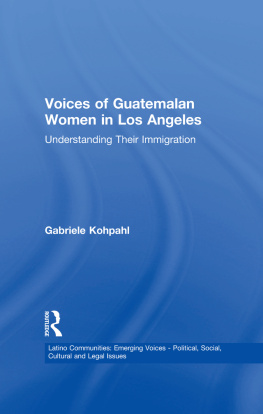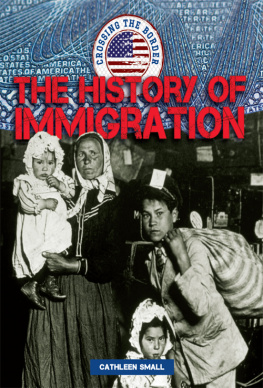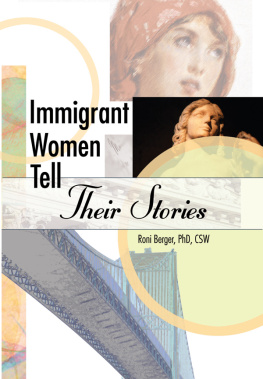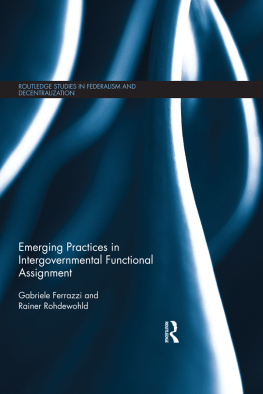LATINO COMMUNITIES
EMERGING VOICES
POLITICAL, SOCIAL, CULTURAL,
AND LEGAL ISSUES
edited by
ANTOINETTE SEDILLO LOPEZ
UNIVERSITY OF NEW MEXICO
A GARLAND SERIES
Voices of Guatemalan Women in Los Angeles
Understanding their Immigration
Gabriele Kohpahl
First published 1998 by Routledge
2 Park Square, Milton Park, Abingdon, Oxon OX14 4RN
711 Third Avenue, New York, NY 10017, USA
Routledge is an imprint of the Taylor & Francis Group, an informa business
First issued in paperback 2016
Copyright 1998 Gabriele Kohpahl
All rights reserved. No part of this book may be reprinted or reproduced or utilised in any form or by any electronic, mechanical, or other means, now known or hereafter invented, including photocopying and recording, or in any information storage or retrieval system, without permission in writing from the publishers.
Notice:
Product or corporate names may be trademarks or registered trademarks, and are used only for identification and explanation without intent to infringe.
ISBN 978-0-8153-3297-8 (hbk)
ISBN 978-1-138-99409-6 (pbk)
Library of Congress Cataloging-in-Publication Data
Catalog record is available from the Library of Congress
Many people made this book possible. I would like to thank my Ph.D. committee for their support. My advisor Carole Browner focused my dissertation research and writing through her sharp and careful comments. Douglas Hollan introduced me to the person centered approach in Anthropology and was an invaluable source of encouragement and assurance. Keith Kernan and Leo Estrada gave me important feedback. Nancy Levine kept me on track and was an invaluable critique of my work. I also would like to thank Johannes Wilbert who supported my coming to the United States and who advised me academically during my first years at UCLA. My special thanks to Ann Walters. Without Ann's advice I never would have been able to pass the numerous bureaucratic requirements of the Ph.D. program. I also would like to thank Madelyn Gianfranceso with helping to get through all the paperwork.
I am indebted to all Guatemalan women who participated in the interviews and gave me their time and trust to share their experience with me. Among the numerous people who helped during my fieldwork in Los Angeles I would like to mention: Norma Chinchilla, Ana Deutsch, Sr. Diane Donaghue, Omar Franco, Nora Hamilton, Sr. Judy Malofski, Carlos Paiva, Lisette Perez, Noemi Perez, Susana Salvatrucci, Paula Sirola and Sr. Patricia Ann Thompson. I would especially like to acknowledge Maria Pu Zapeta, who became an invaluable friend while we were exploring Guatemalan Los Angeles and Fazila Bhimji, whose relaxed attitude often found an easy solution to my problems.
I would like to thank my friends in Los Angeles and in Germany for all their support during the difficult time of my dissertation. I would like to thank the Ashamalla family for their hospitality and taking me into their family. Among my friends I especially would like to thank Silvia Balzano who was a constant source of support through all those years we spent in graduate school and whose long conversation about anthropology fueled my enthusiasm for anthropology. I also would like to thank both, Ana Millaruelo and Silvia Balzano for their help interpreting difficult parts of my interviews and gave me feedback on my ideas.
I would like to thank my parents and my sister in Germany who were a constant and solid source of love and support even from thousands of miles away.
Furthermore, I thank Dr. Sedillo Lopez for her feedbook for changes on my manuscript and Garland Publishing's assistant editor Rebecca Wipfler for assisting me in the process of publication.
An earlier version of has been published in under the title Where do I Find the Women?: Research With Undocumented Guatemalan Refugee Women in Los Angeles. It is reprinted by permission of the American Anthropological Association from Selected Papers on Refugee Issues: III, 1994. Not for further reproduction.
Voices of Guatemalan Women in Los Angeles
Chapter 1
Introduction
Immigration and Naturalization Service (INS) statistics reported that 50 percent of all undocumented immigrants detained at the U.S./Mexican border are women (Golden 1992). Women from Central America and Mexico are entering the United States in increasing numbers. National statistics show that Guatemalan immigration to the United States is female dominated (Donato 1992:161). Guatemalan immigration is part of a trend where more women in an increasing number of countries than men participate in transnational migration (Donato 1992). This research attempts to clarify the causes for this phenomenon. First, it evaluates which Guatemalan women initiators and pioneers in the decision to migrate. Second, it looks at women's diverse reasons for leaving Guatemala, and third, what are the conditions particular to women left behind?
This study will also contribute to an understanding of the increasing diversification of the Latin American immigrant population in the United States (Lopez et al. 1996, Totti 1987). According to the 1990 census, over 65 percent of Los Angeles County's population are immigrants from Latin America. Although the majority of all Latin American immigrants in Los Angeles are from Mexico, there are other large Latin American immigrant communities in the city. Guatemalans are the third largest Latin American immigrant community in Southern California (Brownstein-Santiago 1992, Ramos 1997), but have received very limited attention from social scientists.
The massive influx of Central Americans into Los Angeles occurred only very recently, during the early eighties, due to increased political violence combined with the economic decline of the region. Due to the Central American political and economic crisis Los Angeles has the largest concentration of Central Americans outside Central America (Ramos 1997). As a largely undocumented refugee population, Central Americans belong to the most disenfranchised and politically least influential sections of the population in Southern California (Ward 1987, Ramos 1997). While the Mexican community has produced its own scholarly research and is fighting heavily for a share of power in Los Angeles, Central American voices remain largely silent. Therefore, there is little knowledge about the identity and origin of this section of the population.
Womens Complex and Diverse Motivations for Immigration
This study compares selected case studies of Guatemalan immigrant women who decided to immigrate with cases where the women did not make their own decision to immigrate to the United States. It contributes an understanding of the conditions in Guatemala that prompted their migration. Chant and Radcliffe (1992) pointed out that there is a lack of understanding about the diversity of women's causes for immigration and participation in the decision process for migration within one nationality.
Therefore, this study focuses on a range of conditions that perpetuate Guatemalan women's immigration to the United States such as their personal, marital and familial relationships; gender-role constraints; the socioeconomic and political situations in Guatemala. It especially focuses on how women's marital status affect their opportunity to decide to emigrate and how this intersects with socioeconomic and political causes. Case vignettes demonstrate how different causes are represented differently in each woman's lives.











